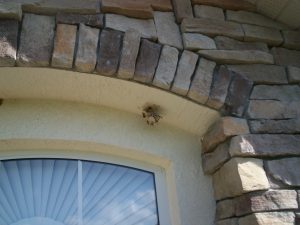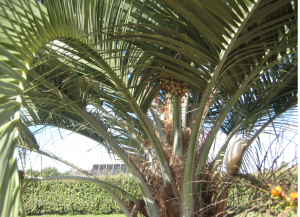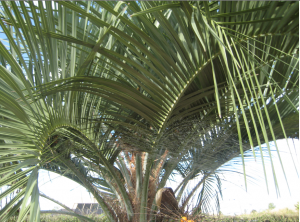I’m not sure if I’m 100% qualified to write on this subject. The truth is I get stung more by paper wasps than any other stinging insect and I don’t see this trend changing anytime soon. The main reason is that while we see many paper wasps nests under the eaves of our homes and avoid those, there are many more nests in the bushes and foliage that we walk by everyday and don’t see. Then when we go to trim or need to walk through the area disturbing the bush we are perceived as a threat and one or two of them will fly out and sting you. In my job I’m always making my way through shrubbery or pushing past palm fronds so I guess getting an occasional sting is inevitable.
Paper wasp background
 Paper wasps also called umbrella wasps get their name because of the nests they construct. Workers can often be seen on fence posts or decks scraping wood fibers with their mouth and flying off to take the material home. They mix it with saliva and build an open nest which is semi water proof and most often is in the shape of an umbrella. These nests have open cells for rearing brood and typically stay small (20 to 30 combs) but I’ve seen some get up to about 200. This wasp can sting multiple times and they are territorial even though you can have several nests within a few feet of each other. The peak of activity is towards the end of summer but with the change of seasons the fertilized queen will find refuge in a crack of a building or under bark to spend the winter but the remaining wasps will die and the nest will be abandoned. There are about 1100 true species of paper wasps worldwide but somewhere in the neighborhood of 300 in America.
Paper wasps also called umbrella wasps get their name because of the nests they construct. Workers can often be seen on fence posts or decks scraping wood fibers with their mouth and flying off to take the material home. They mix it with saliva and build an open nest which is semi water proof and most often is in the shape of an umbrella. These nests have open cells for rearing brood and typically stay small (20 to 30 combs) but I’ve seen some get up to about 200. This wasp can sting multiple times and they are territorial even though you can have several nests within a few feet of each other. The peak of activity is towards the end of summer but with the change of seasons the fertilized queen will find refuge in a crack of a building or under bark to spend the winter but the remaining wasps will die and the nest will be abandoned. There are about 1100 true species of paper wasps worldwide but somewhere in the neighborhood of 300 in America.
The paper wasp warning
These wasps have a tendency to warn intruders that get to close by dive bombing your face and head. This gentle nudge can be quickly followed up with a sting if you aren’t quick enough to give them room. Normally you’ll only get whacked once or twice because they are not considered to be aggressive like bees or bald faced hornets. Another interesting defense of the wasp is that they secrete a chemical around the stalk of the nest where its attached which keeps away ants. This protects the young larval stage which the ants would love if they could get to it and the wasps could do little to fight them off.
Tips for treating and not getting stung
For the most part paper wasps can be easily treated in relative safety. Problems occur when the nest is somewhat secluded and you can’t  get a clear shot. Make sure you assess the situation to see if you should call in a pro or you can always avoid the area until fall when the nest will go into decline. Many homeowners have a product called ‘wasp freeze’ which works extremely well on bees and wasps and if you do you can make quick work of almost any nest. At $17.00 per can it can get a little costly and the contents shoot out quickly so you may only get a few nests treated before you need more. A cheaper way is simply to put a liquid insecticide in a hand pump sprayer and you will get the same results for a fraction of the price. The key is not to over pump it causing excess pressure and to adjust the spray nozzle to fan or cone spray. High pressure will simply knock many of the wasps off the nest and they may fly right to you. If you use a pin stream you’ll get some of the same plus your coverage is limited so again you’ll just be making them mad.
get a clear shot. Make sure you assess the situation to see if you should call in a pro or you can always avoid the area until fall when the nest will go into decline. Many homeowners have a product called ‘wasp freeze’ which works extremely well on bees and wasps and if you do you can make quick work of almost any nest. At $17.00 per can it can get a little costly and the contents shoot out quickly so you may only get a few nests treated before you need more. A cheaper way is simply to put a liquid insecticide in a hand pump sprayer and you will get the same results for a fraction of the price. The key is not to over pump it causing excess pressure and to adjust the spray nozzle to fan or cone spray. High pressure will simply knock many of the wasps off the nest and they may fly right to you. If you use a pin stream you’ll get some of the same plus your coverage is limited so again you’ll just be making them mad.
Fan spray is the key
 With a low pressure fan spray pattern the wasps rarely fly off but will instead stay on the nest while you are coating them with your insecticide. Perhaps they think it is a gentle rain I’m not sure but I rarely have any trouble with this technique. Paper wasp treatment is a quick and easy process but here are a couple words of caution before you march out there to tackle your nest;
With a low pressure fan spray pattern the wasps rarely fly off but will instead stay on the nest while you are coating them with your insecticide. Perhaps they think it is a gentle rain I’m not sure but I rarely have any trouble with this technique. Paper wasp treatment is a quick and easy process but here are a couple words of caution before you march out there to tackle your nest;
Give yourself some cover if you can. Spray from around a corner or from behind an object just for that added layer of protection. Also make sure that the drift from the spray isn’t raining down on you. Use enough pressure that will reach the nest but too much or if you go against the wind you can get more on you than the nest. Scout the area and make sure there isn’t another nest close by where you might be taking cover, they might not like you to close and while your attention is averted you could get stung. As always use common sense and if you are at all allergic or have any doubts–leave it alone– You can always call an exterminator who’ll handle it for you safely and effectively.




